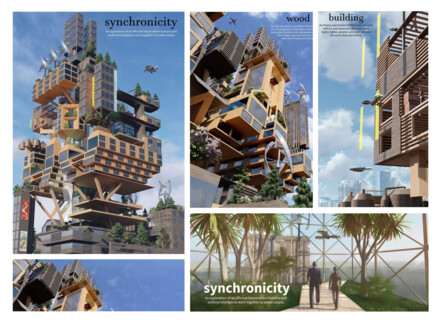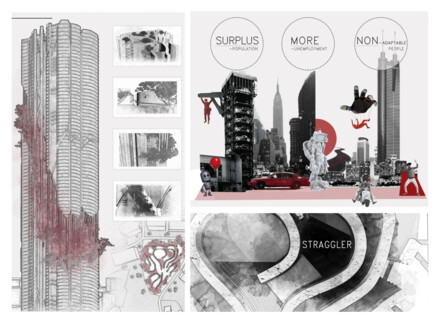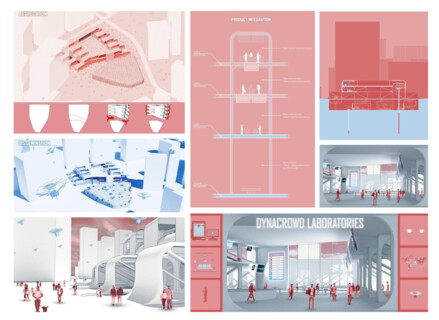- wa-ID
- wa-2026642
- Tag der Veröffentlichung
- 27.05.2019
- Aktualisiert am
- 27.02.2020
- Verfahrensart
- Offener Wettbewerb
- Zulassungsbereich
-
Andere
- Teilnehmer
- Keine Teilnahmebeschränkung
- Auslober
- UNI - UNIEGIS NETWORK Private Limited
- Bewerbungsschluss
- 27.10.2019
- Abgabetermin
- 06.11.2019
- Preisgerichtssitzung
- 07.12.2019
- Bekanntgabe
- 12.02.2020
Verfahrensart
Offener Ideenwettbewerb
Wettbewerbsaufgabe
Während Maschinen sich mit einer enormen Geschwindigkeit entwickeln, werden es Menschen sein, die mit der zunehmenden Automatisierung durch die Schaffung von mehr Wert mithalten müssen, um zu überleben. Menschen müssen heute mehr Stunden mit den sich verändernden Trends der Welt arbeiten - ein Vorläufer, aber dennoch ein bedeutender Indikator für dieses Phänomen heute. Letztendlich fordert dies einen Tribut von dem menschlichen Körper. Wenn wir uns auf die Fähigkeit des menschlichen Gehirns beziehen, sich zu verändern, und nicht auf den Aufwand, der nötig ist, um sich an diese Veränderungen anzupassen, ist es keine Überraschung, dass Fachkräfte mittleren Alters am stärksten von diesem Wandel betroffen sein werden. Der wahrscheinlichste Fall wird unsere zukünftige Generation sein. Wie kann die Menschheit auf einem solchen Abstieg gedeihen, wenn die Technologie immer wieder Dinge lernt und automatisiert? Wird dieser Kampf gegen die Maschine ewig weitergehen?
In der Zukunft, wenn die meiste alltägliche Arbeit automatisiert werden kann, können die Menschen dies als eine Gelegenheit sehen, mehr zu tun. Die Technologie kann, anstatt gegen den Menschen um seinen Lebensunterhalt zu kämpfen, als eine Möglichkeit gesehen werden, seine Zeit besser zu nutzen. Das Thema der diesjährigen Aufgabe besteht darin, herauszufinden, wie Technologie und Mensch in der Zukunft in Einzigartigkeit zusammenarbeiten können.
Wie können in Zeiten, in denen Unternehmen ihre Mitarbeiter mehr arbeiten lassen wollen, Gesundheit und Glück in Bezug auf das Design mit dieser wachsenden Komponente der Arbeit folgen?
Competition assignment
While machines evolve at a tremendous speed, it will be humans who will have to keep up by bringing more value to survive to get tougher with growing automation. Humans today have to work more hours with the changing trends of the world - is a precursor yet significant indicator of this phenomenon today. Eventually, this takes a toll on the human body. If we refer to the ability of the human brain’s ability to change vs. the amount of effort it‘s needed to adapt to them, it’s no surprise that middle-aged professionals will be the worst hit by this shift. The most likely case will be our future generation. How can humankind thrive on such downhill when technology is always learning things and automating them? Will this battle against machine go on forever?
In the future when most mundane work can be automated, humans can view this as an opportunity to do more. Technology, instead of fighting against humans for livelihood, can be seen as an enabler to make better use of their time. The design theme for this year’s challenge is to find how technology and humans can work together in singularity in the times to come.
In times when corporations wanting to make their employees work more, how can health and happiness follow in terms of design, with this growing component of work?
Preisgericht / Jury
Zetao Chen, Co-Founder, Creative Director, FCHA, China
Raanan Stern, Founder, RUST architects, Israel
Offener Ideenwettbewerb
Wettbewerbsaufgabe
Während Maschinen sich mit einer enormen Geschwindigkeit entwickeln, werden es Menschen sein, die mit der zunehmenden Automatisierung durch die Schaffung von mehr Wert mithalten müssen, um zu überleben. Menschen müssen heute mehr Stunden mit den sich verändernden Trends der Welt arbeiten - ein Vorläufer, aber dennoch ein bedeutender Indikator für dieses Phänomen heute. Letztendlich fordert dies einen Tribut von dem menschlichen Körper. Wenn wir uns auf die Fähigkeit des menschlichen Gehirns beziehen, sich zu verändern, und nicht auf den Aufwand, der nötig ist, um sich an diese Veränderungen anzupassen, ist es keine Überraschung, dass Fachkräfte mittleren Alters am stärksten von diesem Wandel betroffen sein werden. Der wahrscheinlichste Fall wird unsere zukünftige Generation sein. Wie kann die Menschheit auf einem solchen Abstieg gedeihen, wenn die Technologie immer wieder Dinge lernt und automatisiert? Wird dieser Kampf gegen die Maschine ewig weitergehen?
In der Zukunft, wenn die meiste alltägliche Arbeit automatisiert werden kann, können die Menschen dies als eine Gelegenheit sehen, mehr zu tun. Die Technologie kann, anstatt gegen den Menschen um seinen Lebensunterhalt zu kämpfen, als eine Möglichkeit gesehen werden, seine Zeit besser zu nutzen. Das Thema der diesjährigen Aufgabe besteht darin, herauszufinden, wie Technologie und Mensch in der Zukunft in Einzigartigkeit zusammenarbeiten können.
Wie können in Zeiten, in denen Unternehmen ihre Mitarbeiter mehr arbeiten lassen wollen, Gesundheit und Glück in Bezug auf das Design mit dieser wachsenden Komponente der Arbeit folgen?
Competition assignment
While machines evolve at a tremendous speed, it will be humans who will have to keep up by bringing more value to survive to get tougher with growing automation. Humans today have to work more hours with the changing trends of the world - is a precursor yet significant indicator of this phenomenon today. Eventually, this takes a toll on the human body. If we refer to the ability of the human brain’s ability to change vs. the amount of effort it‘s needed to adapt to them, it’s no surprise that middle-aged professionals will be the worst hit by this shift. The most likely case will be our future generation. How can humankind thrive on such downhill when technology is always learning things and automating them? Will this battle against machine go on forever?
In the future when most mundane work can be automated, humans can view this as an opportunity to do more. Technology, instead of fighting against humans for livelihood, can be seen as an enabler to make better use of their time. The design theme for this year’s challenge is to find how technology and humans can work together in singularity in the times to come.
In times when corporations wanting to make their employees work more, how can health and happiness follow in terms of design, with this growing component of work?
Preisgericht / Jury
Zetao Chen, Co-Founder, Creative Director, FCHA, China
Raanan Stern, Founder, RUST architects, Israel
Breaking Work - Singularity
Work will never be the same
Organizers
UNI, New Delhi
competitions.uni.xyz
The Premise
The 21st century has seen the most rapid shifts in how we live - what we do, driven by technologies and will continue to steer at a similar pace. From a time when humans were doing most of the work by hand, innovation led to the formation of tools, making our work efficient. The same tools were used to build machines that made work even more effortless for us. Robots are now the next big thing happening where machines could do almost everything; even build themselves. Beyond this, a steady transition has been seen from manual to digital where how we work has changed with these shifts. The humankind’s push to develop more and more in this race to stay ahead, the ways we work has transformed tremendously as well.
A world more connected via digital merging with physical – is now the only norm that is constant.
The Challenge
While machines evolve at a tremendous speed, it will be humans who will have to keep up by bringing more value to survive to get tougher with growing automation. Humans today have to work more hours with the changing trends of the world - is a precursor yet significant indicator of this phenomenon today. Eventually, this takes a toll on the human body. If we refer to the ability of the human brain’s ability to change vs. the amount of effort it‘s needed to adapt to them, it’s no surprise that middle-aged professionals will be the worst hit by this shift. The most likely case will be our future generation. How can humankind thrive on such downhill when technology is always learning things and automating them? Will this battle against machine go on forever?
In the future when most mundane work can be automated, humans can view this as an opportunity to do more. Technology, instead of fighting against humans for livelihood, can be seen as an enabler to make better use of their time. The design theme for this year’s challenge is to find how technology and humans can work together in singularity in the times to come.
In times when corporations wanting to make their employees work more, how can health and happiness follow in terms of design, with this growing component of work?
Competition Type
Open competition
Eligibility
Minimum eligible age for participation is 18 years.
There is no restriction to the degree or design disciplines to participate in the challenge.
Participation in the competition can happen in a team as well as an individual.
There is no restriction to the number of members who can participate in a team.
The challenge is open worldwide for anyone to participate.
Schedule
Seed registration ends: June 14, 2019
Standard registration ends: October 27, 2019
Submission deadline: November 06, 2019
Public voting starts: November 07, 2019
Public voting ends: December 07, 2019
Results announcement: December 17, 2019
More information and documents at
competitions.uni.xyz/breaking-work-singularity
Work will never be the same
Organizers
UNI, New Delhi
competitions.uni.xyz
The Premise
The 21st century has seen the most rapid shifts in how we live - what we do, driven by technologies and will continue to steer at a similar pace. From a time when humans were doing most of the work by hand, innovation led to the formation of tools, making our work efficient. The same tools were used to build machines that made work even more effortless for us. Robots are now the next big thing happening where machines could do almost everything; even build themselves. Beyond this, a steady transition has been seen from manual to digital where how we work has changed with these shifts. The humankind’s push to develop more and more in this race to stay ahead, the ways we work has transformed tremendously as well.
A world more connected via digital merging with physical – is now the only norm that is constant.
The Challenge
While machines evolve at a tremendous speed, it will be humans who will have to keep up by bringing more value to survive to get tougher with growing automation. Humans today have to work more hours with the changing trends of the world - is a precursor yet significant indicator of this phenomenon today. Eventually, this takes a toll on the human body. If we refer to the ability of the human brain’s ability to change vs. the amount of effort it‘s needed to adapt to them, it’s no surprise that middle-aged professionals will be the worst hit by this shift. The most likely case will be our future generation. How can humankind thrive on such downhill when technology is always learning things and automating them? Will this battle against machine go on forever?
In the future when most mundane work can be automated, humans can view this as an opportunity to do more. Technology, instead of fighting against humans for livelihood, can be seen as an enabler to make better use of their time. The design theme for this year’s challenge is to find how technology and humans can work together in singularity in the times to come.
In times when corporations wanting to make their employees work more, how can health and happiness follow in terms of design, with this growing component of work?
Competition Type
Open competition
Eligibility
Minimum eligible age for participation is 18 years.
There is no restriction to the degree or design disciplines to participate in the challenge.
Participation in the competition can happen in a team as well as an individual.
There is no restriction to the number of members who can participate in a team.
The challenge is open worldwide for anyone to participate.
Schedule
Seed registration ends: June 14, 2019
Standard registration ends: October 27, 2019
Submission deadline: November 06, 2019
Public voting starts: November 07, 2019
Public voting ends: December 07, 2019
Results announcement: December 17, 2019
More information and documents at
competitions.uni.xyz/breaking-work-singularity







